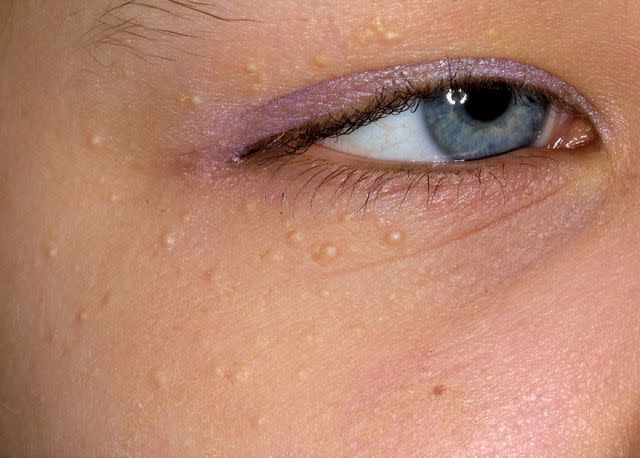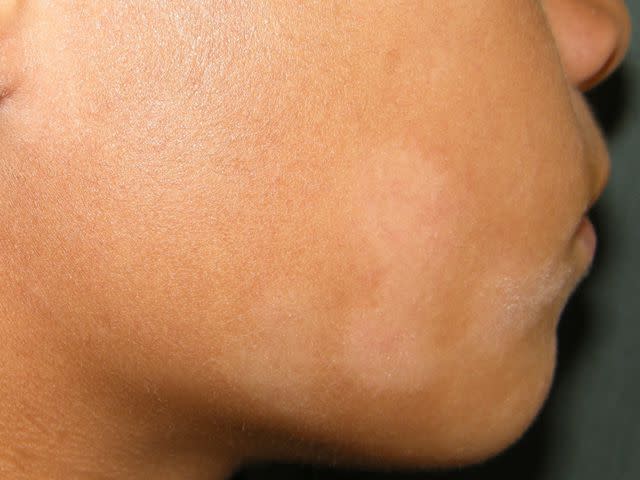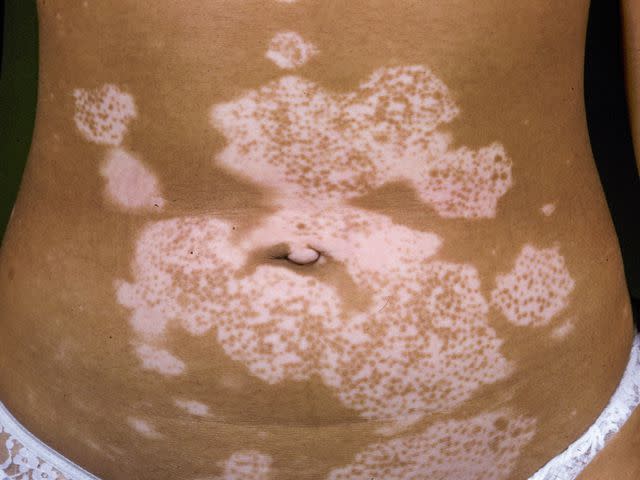How White Spots on Skin Look in Pictures
Medically reviewed by Marisa Garshick, MD
White spots on the skin can be caused by a loss of skin pigment or from trapped skin cells. They are usually benign and need minimal treatment.
This article will show pictures of white spots on the skin and discuss their cause. It will also cover treatment options and when to see a healthcare provider for additional therapies.

SolStock / Getty Images
Pictures of White Spots on Skin Based on Cause
White spots or patches on the skin can create serious concerns for some people. Below are several different causes of white spots.
Milia

Reproduced with permission from © DermNet and © Raimo Suhonen dermnetnz.org 2023
Milia are tiny white bumps often found on the eyelids, cheeks, and nose. They are keratin-filled cysts that do not cause any pain or itching.
The skin continuously exfoliates itself. When skin cells do not properly exfoliate and get trapped under the skin, it can form milia.
Milia looks similar to whiteheads, which may make it tempting to pop or squeeze them. However, this should be avoided because it can cause scarring. At-home treatments include exfoliators, facial peels, or retinol. If milia does not resolve with home treatment, a dermatologist can provide additional treatment options.
Pityriasis Alba

Pityriasis alba is a common childhood skin condition that begins with red, scaly patches. It is typically seen on the cheeks and chin but can occur anywhere. As the patches heal, they leave an area of hypopigmentation (skin lighter-colored than the surrounding skin). The hypopigmentation is not permanent.
Pityriasis alba has no known cause but tends to occur in people with dry skin and atopic dermatitis.
Most people with pityriasis alba will not need treatment. However, a moisturizer can alleviate dryness, and a topical steroid can relieve itching if necessary.
Guttate Hypomelanosis
Reproduced with permission from © DermNet dermnetnz.org 2023
Guttate hypomelanosis, also known as sun spots, is a skin condition characterized by flat white spots on the skin. These spots are typically small, about 1 to 3 millimeters in diameter. No other symptoms, like itching or pain, are associated with the spots.
The exact cause of guttate hypomelanosis is not known but is likely due to sun exposure and genetics. They tend to appear as people age, affecting 50% to 80% of those 40 years and older.
Guttate hypomelanosis can be an appearance concern for some but typically does not need to be treated. A dermatologist may be able to offer certain treatments to those who would like to lessen the appearance of the white spots.
Vitiligo

Reproduced with permission from © DermNet and © Dr Richard Ashton dermnetnz.org 2023
Vitiligo is an autoimmune condition that causes areas of the skin to lose pigmentation. This causes milky-white areas on the skin that tend to be symmetrical with both sides of the body. Vitiligo is most often seen on the hands, arms, face, and feet.
These white patches tend to start before the age of 20. There is no cure for vitiligo, but treatments can help stop it from progressing. Treatments work to stop the immune system from destroying the skin's pigmentation. This can include corticosteroids, calcineurin inhibitors, or phototherapy.
White Skin Spot Removal With Topicals
White skin spots have several different causes, which will determine the treatment plan. Often, these spots do not need treatment. However, conditions like vitiligo do need to be treated.
Topical treatments for vitiligo include:
Corticosteroids: Anti-inflammatory medication that can slow vitiligo and allow pigment cells to return.
Calcineurin inhibitors: Stop the body from attacking the pigment-producing cells.
Calcipotriene: A derivative of vitamin D that stimulates pigment production.
Topical or oral JAK inhibitors: Targets JAK, which is involved in cytokine signaling.
Guttate hypomelanosis does not need to be treated. However, if the appearance of the spots is bothersome, topical treatment options include steroids, tretinoin, and pimecrolimus.
Topical treatments for pityriasis alba are moisturizers for dryness and topical steroids to relieve itching.
Milia can be treated with topical retinol to help encourage skin cell turnover.
Steps to Getting White Skin Spots Diagnosed
White spots on the skin should be seen by a healthcare provider who specializes in dermatology. They will be able to evaluate the skin and determine the underlying cause. When the cause is unknown, the dermatologist may use various diagnostic tools. These may use skin biopsy, wood lamp examination, or blood tests.
Summary
Small white spots on the skin can be caused by loss of pigment or from trapped skin cells. Treatment will vary based on the underlying cause. A dermatologist is a healthcare provider who specializes in skin and should be seen to evaluate the white spots to determine the best care plan.
Read the original article on Verywell Health.

